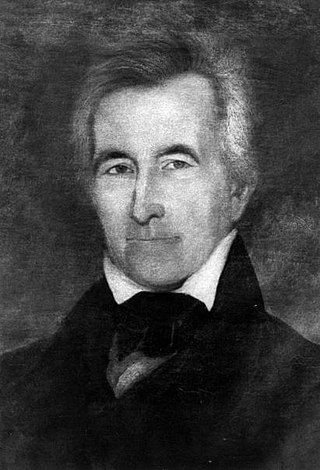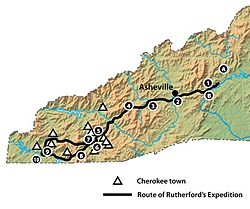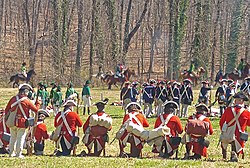
William Sharpe was a lawyer, politician, American Revolution patriot, and a delegate to the Continental Congress from Rowan County, North Carolina, which became Iredell County in 1788.
The Hillsborough District Brigade of militia was an administrative division of the North Carolina militia established on May 4, 1776. Brigadier General Thomas Person was the first commander. Companies from the eight regiments of the brigade were engaged in 55 known battles and skirmishes in North Carolina, South Carolina, and Georgia during the American Revolutionary War. It was active until the end of the war.

William Lee Davidson (1746–1781) was an officer in the North Carolina militia and Continental Army during the American Revolutionary War. He was born in Pennsylvania and moved with his family to Rowan County, North Carolina in 1750. He was killed at the Battle of Cowan's Ford.

Griffith Rutherford was an American military officer in the Revolutionary War and the Cherokee-American Wars, a political leader in North Carolina, and an important figure in the early history of the Southwest Territory and the state of Tennessee.
Joseph Hardin Sr. was an Assemblyman for the Province of North Carolina, and was a signatory of the Tryon Resolves. Early in the War for Independence, as a member of the militia from Tryon County, Hardin fought the Cherokee allies of Britain along the western frontier. Later in the war, having taken his family over the Appalachian Mountains to the Washington District for safety against the advance of the Red Coats out of South Carolina, Hardin joined the Overmountain Men. He saw action at the Battle of Ramsour's Mill and the decisive Battle of Kings Mountain. Following the peace with Britain, Hardin was a co-founder and second Speaker of the House for the State of Franklin; and an Assemblyman in the Southwest Territory before its statehood as Tennessee.
James Johnston was an officer in the Tryon County Regiment and Lincoln County Regiments of the North Carolina militia in the American Revolution, a delegate to the North Carolina Provincial Congress in 1776, and a state senator in 1780–1782.
The Salisbury District of North Carolina, was originally one of six colonial judicial districts established in 1766 by the Governor William Tryon of the Province of North Carolina. Immediately preceding the onset of the American War of Independence in 1775, these six regions were renamed "military districts" by the North Carolina Provincial Congress and used for organizing the North Carolina militia. The other military districts were Edenton, Halifax, Hillsborough, New Bern, and Wilmington districts. The military district designation was discontinued in 1835 during the North Carolina Constitution Convention.
Adlai Osborne was a lawyer, public official, plantation owner, and educational leader from Rowan County, North Carolina. During the American Revolution, he served on the Rowan County Committee of Safety and commanded the 2nd Rowan County Regiment of the North Carolina militia. He was elected as a delegate to the Continental Congress, but did not serve. In 1789, he was a delegate to the convention in Fayetteville that ratified the United States Constitution.
Francis Locke Sr. (1722–1796) was a plantation owner, businessman, politician, and a participant in the American War of Independence, where he led the American Patriots to the decisive victory at Ramseur's Mill, which turned the tide of the American War for Independence in the south.
The Salisbury District Brigade was an administrative division of the North Carolina militia during the American Revolutionary War (1776–1783). This unit was established by the Fourth North Carolina Provincial Congress on May 4, 1776, and disbanded at the end of the war.
The 2nd Rowan County Regiment was first established in October 22, 1775 as a local militia in Rowan County in the Province of North-Carolina. This regiment was created from the existing Rowan County Regiment of militia. Its original officers were Col Adlai Osborne, Lt Col Christopher Beekman, and Major Charles McDowell. Adlai Osborne was a leader in Rowan County and member of the Rowan County Committee of Safety. On May 9, 1777, the regiment was renamed the Burke County Regiment, which was active until the end of the Revolutionary War in 1783.
The Guilford County Regiment was authorized on September 9, 1775 by the Third North Carolina Provincial Congress. It was subordinate to the Salisbury District Brigade of militia. The regiment was engaged in battles and skirmishes against the British and Cherokee during the American Revolution in North Carolina, South Carolina and Georgia between 1776 and 1781. It was active until the end of the war.
The Surry County Regiment was established on August 26, 1775 by the North Carolina Provincial Congress. The regiment was engaged in battles and skirmishes against the British and Cherokee during the American Revolution in North Carolina, South Carolina Tennessee, and Georgia between 1776 and 1782. It was active until the end of the war.
The Rutherford County Regiment was authorized on October 30, 1779, by the Province of North Carolina Congress. It was created at the same time that Rutherford County, North Carolina was created out of the western part of Tryon County, North Carolina when Tryon County and its regiment of militia were abolished. Officers were appointed and commissioned by the Governor. The regiment was engaged in battles and skirmishes against the British during the American Revolution in North Carolina, Georgia, and South Carolina between 1779 and 1782. It was active until the end of the war.

The Washington District Regiment was authorized on December 23, 1776 by the Province of North Carolina Congress. It was subordinate to the Salisbury District Brigade of militia. The regiment was renamed the Washington County Regiment. The regiment was engaged in battles and skirmishes against the British and Cherokee during the American Revolution in Virginia, North Carolina, South Carolina, Tennessee, and Georgia between 1776 and 1782. It was active until the end of the war.
The Mecklenburg County Regiment was authorized on May 31, 1775 by the Province of North Carolina Congress. From November 7, 1779 until the 3rd Quarter of 1780, it was called the 1st Mecklenburg County Regiment when a 2nd Mecklenburg County Regiment existed. The 1st Mecklenburg County regiment was engaged in 39 known battles and skirmishes against the British during the American Revolution in North Carolina, South Carolina and Georgia between 1776 and 1781. It was active until the end of the war.
The Edenton District Brigade was an administrative division of the North Carolina militia during the American Revolutionary War (1776–1783). This unit was established by the North Carolina Provincial Congress on May 4, 1776, and disbanded at the end of the war.

The Halifax District Brigade was an administrative division of the North Carolina militia during the American Revolutionary War (1776–1783). This unit was established by the North Carolina Provincial Congress on May 4, 1776, and disbanded at the end of the war.
North Carolina state troops in the American Revolution were the initial military units created in a transition from the Province of North Carolina under British rule to independence from British rule. Most units did not last long as such and were either transferred to the Continental Army or state militia instead.







